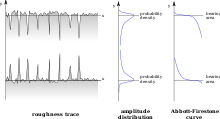Abbott-Firestone curve
The Abbott-Firestone curve or bearing area curve (BAC) describes the surface texture of an object. The curve can be found from a profile trace by drawing lines parallel to the datum and measuring the fraction of the line which lies within the profile.[1]

Mathematically it is the cumulative probability density function of the surface profile's height and can be calculated by integrating the profile trace.[2]
The Abbott-Firestone curve was first described by EJ Abbott and FA Firestone in 1933.[3] It is useful for understanding the properties of sealing and bearing surfaces. It is commonly used in the engineering and manufacturing of piston cylinder bores of internal combustion engines.[4] The shape of the curve is distilled into several of the surface roughness parameters, especially the Rk family of parameters.
References
- Johnson, K. L. (1985). Contact Mechanics. Cambridge University Press. p. 407. ISBN 0-521-34796-3.
- Stachowiak, G. W.; Batchelor, A. W. (2001). Engineering tribology. Boston: Butterworth-Heinemann. p. 450. ISBN 0-7506-7304-4.
- Abbott, E.J.; F.A. Firestone (1933). "Specifying surface quality: a method based on accurate measurement and comparison". Mechanical Engineering. 55: 569–572.
- Flitney, Robert. Seals and Sealing Handbook, Fifth Edition. Elsevier Science. p. 484. ISBN 1-85617-461-1.